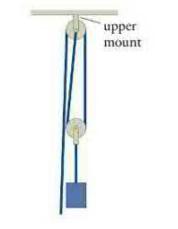The pair of pulleys shown in Figure P9.31 is used to lift a (50-mathrm{kg}) block (0.25 mathrm{~m}).
Question:
The pair of pulleys shown in Figure P9.31 is used to lift a \(50-\mathrm{kg}\) block \(0.25 \mathrm{~m}\). The constant acceleration of the block during the lift is \(+2.5 \mathrm{~m} / \mathrm{s}^{2}\), and the pulleys and rope have negligible inertia and negligible friction. What is the tension
\((a)\) in the pulling rope and
\((b)\) in the rope from which the block hangs?
(c) What force is exerted by the upper mount on the top pulley?
(d) How much work is done by the person pulling the rope in lifting the block \(0.25 \mathrm{~m}\) ?
(e) By how much does the kinetic energy of the block change in this process?
\((f)\) How much work is done on the block by the rope attached to it?
\((g)\) How much work does the ceiling do in this process?
(h) How much work does Earth do on the block?
(i) Draw energy diagrams for three systems during the lifting; block; block and Earth; block, Earth, pulleys, rope, and person.
Data from Figure P9.31

Step by Step Answer:





